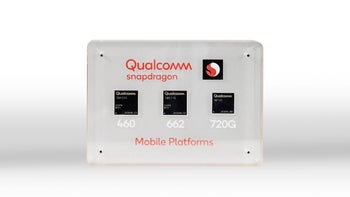Cheap phones are about to get a lot better with Qualcomm's new chips

5G might be what everyone is talking about but the reality is that 4G will remain the backbone of our wireless communications for at least a few more years. Besides that, many markets haven’t even begun implementing 5G. Keeping that in mind, Qualcomm has released three new chips to suit the needs of manufacturers and users that are still shying away from the new technology.
The three chips span from the upper mid-range to the low end. They follow Qualcomm’s familiar naming scheme making it easy to recognize which is which: Snapdragon 720G, 660 and 460.
All three get features we’re used to seeing on high-end phones. When it comes to connectivity, that means Wi-Fi 6, Bluetooth 5.1 with Qualcomm FastConnect for better audio experience and of course, higher 4G max speeds (exactly how high depends on the chip).
That being said, let’s briefly check what each of the new chips has to offer.
The Snapdragon 720G is meant to satisfy the needs of mobile gamers that don’t quite have the budget for a Snapdragon-865-powered phone. The chip has 8 Kryo 465 cores that can boost up to 2.3GHz and are paired with the Adreno 618 GPU. With the 720G, consumers will get “HDR gameplay, dynamic color range and contrast, realistic and immersive in-game environments and high-quality, synchronized sound.”
Not everything is about gaming, however, the new and improved ISP now supports photo capture up to 192MP, in case there’s a manufacturer that wants to go all out with megapixels.
Naturally, Qualcomm has also crammed a bunch of its own tech goodies we won’t bore you with, but you can check at the chip’s information page.
What we will mention, however, is that the 720G is manufactured using an 8nm process, which means it will have not only better performance, but lower power consumption as well.
The Snapdragon 662 is perhaps the most boring chip of this lineup. It’s a slightly less powerful octa-core chip (Kryo 260, up to 2GHz) that has all the expected improvements but nothing particularly noteworthy. The 662 a cookie-cutter mid-range chip that will quietly do what it’s supposed to without any thrills or headaches. There’s no 4K video recording, cameras can only go as high as 48MP and it’s made using the 11nm Process Technology. That's not to say it's a bad chip, it's just kind of bland.
The Snapdragon 460, on the other hand, has the most potential for making an impact. Sure, it’s a chip for budget devices that won’t wow anyone, but the improvements Qualcomm has achieved with this little guy are impressive.
All three get features we’re used to seeing on high-end phones. When it comes to connectivity, that means Wi-Fi 6, Bluetooth 5.1 with Qualcomm FastConnect for better audio experience and of course, higher 4G max speeds (exactly how high depends on the chip).
GPS improvements are also present with support for Dual-Frequency. And we can’t forget about our other favorite buzz word: AI. Even Qualcomm’s low-end chips will now have AI capabilities that will help with “user experiences across photography, voice assistants, and virtually always-on scenarios for increased contextual awareness.” Now, the help of AI can often be hard to measure, but let’s trust Qualcomm on this one that there will be noticeable benefits for the users.
That being said, let’s briefly check what each of the new chips has to offer.
Snapdragon 720G: G is for Gaming
The Snapdragon 720G is meant to satisfy the needs of mobile gamers that don’t quite have the budget for a Snapdragon-865-powered phone. The chip has 8 Kryo 465 cores that can boost up to 2.3GHz and are paired with the Adreno 618 GPU. With the 720G, consumers will get “HDR gameplay, dynamic color range and contrast, realistic and immersive in-game environments and high-quality, synchronized sound.”
Not everything is about gaming, however, the new and improved ISP now supports photo capture up to 192MP, in case there’s a manufacturer that wants to go all out with megapixels.
What we will mention, however, is that the 720G is manufactured using an 8nm process, which means it will have not only better performance, but lower power consumption as well.
Snapdragon 662: the unremarkable middle child
Snapdragon 460: the little bro gained some muscle
The 8 Kryo 240 cores perform 70% better and the GPU is only slightly behind with 60% improvement, according to Qualcomm. When all other upgrades are considered, the company says this chip delivers twice the performance compared to the previous generation. That’s a big win for budget smartphones.
The Qualcomm Spectra 340 ISP that comes with the Snapdragon 460 should not only improve the image quality of photos but also supports triple cameras.
Better performance and better cameras, what more can you want? This chip seems perfect for Nokia’s budget phones and it will be interesting to see how well it does in the real world.
Speaking of the real world, when can you expect o see phones with these new chips? Well, Qualcomm says the Snapdragon 720G will make an appearance in Q1 of 2020. This means in two months max we should see at least one smartphone powered by it.
The timeline for the 662 and 460 is a bit foggier, but devices based on them are expected by the end of the year.












Things that are NOT allowed: